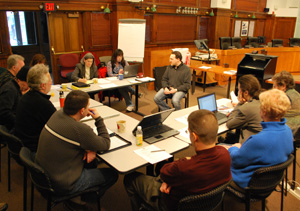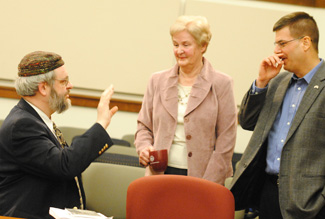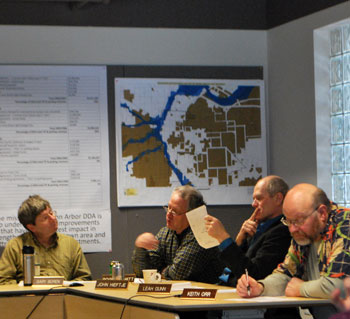Washtenaw County board of commissioners retreat (Jan. 29, 2011): A budget retreat for county commissioners last Saturday – also attended by other elected county officials and staff – laid some groundwork for tackling Washtenaw County’s two-year, $20.9 million projected deficit.

At their Jan. 29 retreat, Washtenaw County commissioners, staff and other elected officials gathered to talk about the county's budget priorities. The retreat was led by commissioner Conan Smith, the board's chair, who's sitting in the center of the horseshoe table. Other participants are sitting around the room's perimeter, off camera. (Photos by the writer.)
While no decisions were made, the group took steps toward reaching consensus on budget priorities. They identified among their main concerns: public safety, service delivery and human services. At the end of the five-hour session, several commissioners cited the main benefit of the day as building closer relationships with each other, which they hope will help the board and other elected officials – including the sheriff, prosecuting attorney and treasurer – work together more effectively as they make difficult decisions about programs and services to cut.
The retreat was led by board chair Conan Smith, who structured the day with time for sharing individual priorities and concerns, combined with small group work to discuss specific outcomes the commissioners hope will result from those priorities. For example, if public safety is a priority, a possible outcome might be the goal of responding to a 911 call in 20 minutes or less. The county could then budget its resources to achieve that outcome.
Though these kinds of examples emerged during the retreat, the work of setting priorities will continue. Smith said the goal is to develop a formal board resolution outlining their priorities, to guide the budget-setting process. The board will hold its next retreat on Wednesday, Feb. 9 from 6-9 p.m., immediately following its 5:30 p.m. administrative briefing. Both meetings are public, and will be held at the county administration building, 220 N. Main St. in Ann Arbor.
The county’s fiscal year mirrors the calendar year, and budgets are developed on two-year cycles. The current budget runs through the end of 2011. While there will likely be some additional cuts this year, most discussions are focused on the 2012-2013 budget, which commissioners will be asked to approve by the end of this year. [For additional background, see Chronicle coverage: "'State of County' Tackles $20M Deficit"]
This report summarizes Saturday’s discussions of personal priorities, aspirations for Washtenaw County, budget priorities, and reflections on the process. For breakout sessions, we covered the group focused on public safety. By day’s end there were threads of optimism – Yousef Rabhi, one of four new commissioners, said he felt inspired that they were starting to work not just as a team, but “almost as a family.” But notes of caution were sounded as well, as veteran commissioner Wes Prater told the group that “the most difficult part is yet to come.” [Full Story]










